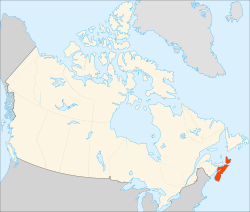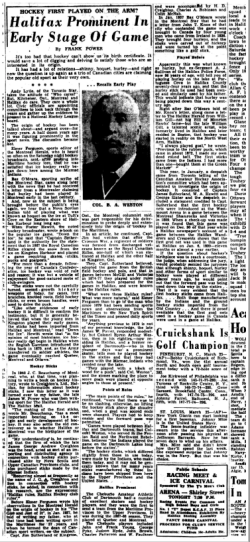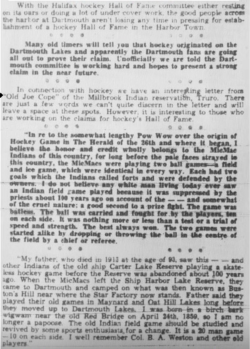Nova Scotia
Nova Scotia is one of three Maritime provinces in Canada. It has a population of about 950,000 and its capital is Halifax.
History of hockey in Nova Scotia
The small town of Windsor (population 3,600) maintains a claim as the birthplace of hockey, based upon a reference (in a novel by Thomas Haliburton) of boys from King's Collegiate School playing "hurley", on the frozen waters of Long Pond adjacent to the school's campus during the early 19th century. Students from King's-Edgehill School still play hockey on Long Pond, a pond proclaimed by some as the "Cradle of Hockey", located at the farm of Howard Dill. Windsor also boasts the oldest hockey arena in Canada, the Stannus Street Rink, built in 1897, which no longer hosts hockey games.
In a 1900 edition of the Windsor Hants Journal, a woman referred to as Mrs. Gould made several mentions of hockey/ricket being played in the Dartmouth area in the 1840s. "[Mr. John McNab] was always against Dan Murphy, a Dartmouth champion, in the ricket and hockey matches. William Foster, senior, the cigar manufacturer, was fond of the game, and always stood ricket guard with his creepers [i.e. soft-soled shoes] on, as he was not a skater." A bit later, she was quoted as saying, "The Dartmouth Lakes and the small ponds were the only resorts of skaters and ricket players-the game now known as hockey."
A Boston Evening Gazette article from November 5, 1859, makes reference to an early game of hockey on ice (called ricket) being played in the province. "Fancy skating is not so much practiced in Nova Scotia now as formerly; more attention is paid to games on the ice. Ricket is the favorite pastime, and is played thus. Two rickets are formed at about the same distance, one from the other, that cricketers place their wickets. If there are many players, the rickets are further apart. A ricket consists of two stones – about as large as the cobble stones with which some of our streets have been lately paved – placed about three or four feet apart and frozen to the ice. Sides are then formed by two persons – one opposed to the other – tossing or drawing lots for first choice of partners. The one who obtains the first choice selects one from the crowd, the other party then chooses another, and so on alternately, until a sufficient number is obtained on each side. Any number can play the game, and, generally, the 'more the merrier.' Each ricketer is provided with a hurley (or hockey, as it is termed here,) and all being ready, a ball is thrown in the air, which is the signal to commence the play, previous to which, however, a ricket is chosen by each side and placed in charge of a man whose duty it is to prevent the ball from passing through. The game may be 10, 15 or 20, or any number agreed upon, the side counting the number first being winners. The counting consists in putting the ball through your adversary’s ricket, each time counting one. From the moment the ball touches the ice, at the commencement of the game, it must not be taken in the hand until the conclusion, but must be carried or struck about ice with the hurlies. A good player – and to be a good player he must be a good skater – will take the ball at the point of his hurley and carry it around the pond and through the crowd which surrounds him trying to take it from him, until he works it near his opponent’s ricket, and 'then comes the tug of war,' both sides striving for the mastery. Whenever the ball is put through the ricket the shout “game ho!” resounds from shore to shore and dies away in hundreds of echoes through the hills. Ricket is the most exciting game that is played on the ice."
There was an interesting passage in a letter written by Thomas Randall to DL Fisher in 1954. "In my research for the Halifax book I came across several references to hockey played on the ice in the latter 18th and early 19th centuries. These references were in letters and newspapers, but I did not make exact note of the sources because the point did not seem of historical value, and I invariably came across them in looking for something else." In his 1948 book, Warden of the North, the following was written: "It is a fact little known in Canada, but a fact none the less, that ice hockey, Canada's national game, began on the Dartmouth Lakes in the eighteenth century. Here the garrison officers found the Indians playing a primitive form of hurley on the ice, adopted and adapted it, and later put the game on skates. When they were transferred to military posts along the St. Lawrence and the Great Lakes they took the game with them and for some time afterwards continued to send to the Dartmouth Indians for the necessary sticks."
Dr. C. Bruce Fergusson wrote an essay entitled Early Hockey at Halifax in 1965, notably saying "Haligonians might just as well say that since troops were stationed at Halifax from 1749 it is quite possible that English troops played hockey as long ago as that year. There is also the likelihood that hockey was played on the Dartmouth Lakes in the eighteenth century. Perhaps the game was played by the Micmacs, as it has been stated, at Tufts Cove on Halifax Harbour, in the eighteenth century, and earlier also, with a rounded block of wood as a puck, and with eight men on each team."
The following appeared in the January 4, 1859 edition of the Halifax British Colonist: The Young Men of Halifax: “We have long held the opinion that the young men of this city are second to none in the world of energy, skill and daring, in all manly games and exercises… Often have we been led to express the same opinion, when the bat laid aside, skates strapped on, and hurley in hand, the ball is followed over the glassy surface of the lakes, which ring to the skates’ heel….”
The "Halifax Rules" were published in 1943 by a Nova Scotia newspaper reporter named James Power, who was known colloquially as 'The Dean of Canadian Sports Reporters.' Power recorded the rules as related to him by Byron Weston who had become the president of the Dartmouth Amateur Athletic Association and who had played in the Halifax-Dartmouth area as early as the 1860s with teams from the area including native Mi'kmaq players. The rules are purported to have been used in the Halifax-Darmouth area prior to hockey being played in Montreal (starting in 1875), however no contemporary sources confirm this. A lengthy article on early hockey activities in Halifax appeared in the March 26, 1943, edition of the Halifax Mail. In a letter to the Halifax paper, Mi'kmagi Joe Cope stated, "I well remember Col B.A. Weston and other old players." Cope also made mention of 10-player teams in those early games.
Dr. John P. Martin researched early hockey activities in Nova Scotia and published an article entitled "The Birthplace of Hockey" in 1955. Some quotes from the article were included in Martin W. Jones's Hockey's Home: Halifax-Dartmouth: the origin of Canada's game book. He wrote the following: "Indoor skating rinks were first introduced in Canada in the early 1860s. One of the first covered ice rinks in Canada was erected at Horticultural Gardens in Halifax in 1863, just months after the Victoria Skating Rink was opened in Montreal. The pioneer skating rink was a wooden structure 180 x 60 feet (55 x 18 m), with an arched roof that was illuminated with coal gas. A reception room with a stove was located near the main entrance. A raised platform at the opposite end of the building was built to accommodate a band."
Dr. Martin stated that organized hockey games were played at the rink during the winter of 1863 and were often covered in the local newspapers. A quote follows: "Hockey must have been a game of long standing in and about Halifax, because the newspapers did not comment on anything extraordinary about the contests: which suggests that their readers were well acquainted with hockey procedure and practices. The only seeming novelty was that the game was played indoors for the first time, and necessarily limited the number of players on each side."
However, in 2023 a group of hockey historians checked the Acadian Recorder, Halifax Morning Sun, Halifax British Colonist, Halifax Evening Express, Halifax Morning Chronicle, and Nova Scotian newspapers from 1863, and found no references to hockey games being played on the Horticultural Gardens rink that winter. There were advertisements for skates, mentions of skating and bands playing at the rink, and a report of a cricket match on the ice between the 17th Regiment and the Halifax Cricket Club on the North West Arm, but nothing about hockey. Thus, Dr. Martin's claims were not able to be corroborated.
The January 2, 1864, edition of The Halifax Reporter wrote the following: "...If we turn towards the country, we are at once struck by the almost total absence of stone throwing boys, upon whose characteristics and mode of life we remarked in a former article. What has become of them? The nearest pond answers this question; they are playing hockey on the ice and occasionally mimicking the mistakes of such among their betters as are not quite at home upon skates..." The game also came up in the January 25 edition of the Halifax Morning Sun: “Hockey ought to be sternly forbidden, as it is not only annoying but dangerous. In its right place, hockey is a noble game, and deserving of every encouragement, but on the ice it is in its wrong place, and should be prohibited.”
There was another newspaper article, published in the February 19, 1867 edition of The Halifax Evening Reporter, discussing activities at Oathill Lake in Dartmouth on the 16th. "Two well contested games of 'ricket' were being played. At the upper end were a number of young men from Dartmouth and the City, playing their 'hurleys' and 'following up' the ball while the centre was occupied by a number of officers of the Garrison and Fleet, in a match game called hockey i.e. ricket."
The Exhibition Rink, situated on Tower Road in Halifax, opened on January 5, 1880. The Halifax Wanderers were organized into a club in 1882.[1] The first documented indoor game in Halifax took place on March 27, 1883. The Wanderers split into a Red side and a Blue side to put on a hockey game in February 1884.[2] By 1885, hockey was popular in both Halifax and Dartmouth (where a rink had opened in 1884). In January 1885, a roller polo team from St. John, New Brunswick, traveled to Halifax to play the local Wanderers team at the roller rink, the former winning 3-0. The Dartmouth Chebuctos were regarded as champions of Nova Scotia every year from 1885-1894. The team was undefeated throughout the Maritimes from 1887-1894 and played exhibition games in Montreal in 1889. The first recorded game in Windsor was played on February 21, 1888. The Windsor Juniors won the first league to be arranged in the province, the Windsor Town League, in 1888-89. By 1900 the town competition had four teams vying for the Citizens Trophy. The Windsor Avonians won the trophy three years in a row from 1900-1902, thus earning it permanently. The Windsor Citizen’s Hockey Trophy was first handed out in 1903 to the Resolute Hockey Team. This cup was competed for until 1953.
The inaugural season of the Halifax City Hockey League took place in 1894, with the first game being played on February 10. Six teams played in the league - Dartmouth Chebuctos, Dartmouth Mutuals, Dalhousie University, Halifax Crescents, Halifax North West Arm, and Halifax Wanderers. Numerous other competitions sprung up in Halifax and its surrounding area (including bankers, college, intermediate, and junior leagues). The most interesting league to emerge was the Coloured Hockey League, an all-black competition founded in Nova Scotia in 1895, which featured teams from across the Maritimes. The league remained active until 1930. With as many as a dozen teams, over 400 African Canadian players from across Nova Scotia, New Brunswick and Prince Edward Island participated in competition.
The first Maritime Championship for the Starr Trophy was held in 1905. It had previously been awarded to the Halifax City League champions from 1897-1903, and the Nova Scotia provincial champion in 1904. The trophy was won permanently by the Moncton Victorias from New Brunswick after they claimed three straight Maritime titles from 1907-1909. A new trophy, known as the Starr Shield, was put up for competition in 1910. In 1923, the Charlottetown Abegweits of Prince Edward Island won it for the third time, earning it for good. Another Starr Shield was then made in 1924.
The Halifax Crescents became the first team from Nova Scotia to challenge for the Stanley Cup in 1900. The same year, the Amherst Ramblers were said to have been league champions of Cape Breton and Nova Scotia.[3] The Cape Breton Hockey League, which initially featured teams from Sydney and North Sydney, was underway by 1901. It expanded to Glace Bay by 1905. There was also an Antigonish-Pictou County League. The province-wide Nova Scotia Hockey League was established for the 1903-04 season. The Amherst Ramblers, New Glasgow HC, Windsor HC, Truro Colts, and two teams from Halifax (Crescents and Wanderers) made up the league. The New Glasgow Cubs challenged for the Stanley Cup in 1906. The Western Nova Scotia Senior Hockey League was played from 1907-1914. The South Shore Hockey League featuring teams from Lunenberg, Bridgewater, and Liverpool was contested in 1910-11 and 1912-13.
The first openly professional games in Nova Scotia were played in February 1910, when the Truro Colts and Halifax Crescents of the NSHL declared themselves professional. The North Sydney Victorias also turned pro, and faced the Crescents for the Nova Scotia Professional Championship, which the latter team won, 2-games-to-one. The Amherst Ramblers defeated an amateur Crescents team 17-0 for the amateur Nova Scotia Championship. Given the turmoil and watered down state of amateur hockey in the province, the Starr Trophy trustees rejected all Nova Scotia team's challenges for the cup in 1910. The Nova Scotia and Cape Breton leagues both folded in 1911, unable to keep up with the professional squads.
Teams from Nova Scotia stocked the Interprovincial Professional Hockey League (1910-11), Maritime Professional Hockey League from (1911-1914), and the Eastern Professional Hockey League (1914-15). The Sydney Millionaires made Nova Scotia's third Stanley Cup challenge in 1913. The Cape Breton Hockey League was contested from 1915-1922, and was replaced by the Cape Breton County Professional Hockey League, which lasted only a single season, for 1922-23.
The first intercollegiate hockey competition in the Maritimes was the Hewson Cup, which was first played in 1906 and featured teams from New Brunswick and Nova Scotia. It was succeeded by the Intercollegiate Hockey League in 1909 and the Maritime Intercollegiate Athletic Association (now Atlantic University Sport) in 1920. Nova Scotia competed for the first Maritime Senior Championship (for the Starr Shield) in 1921, and the Junior Championship in 1932.
Overview
|
|
League, regional and national championships
| Championship | Times won | Description |
| Calder Cup | 4 | American Hockey League champion |
| President's Cup | 1 | Quebec Major Junior Hockey League champion |
| Memorial Cup | 1 | Canadian Major-Junior national champion |
| Allan Cup | 3 | Canadian senior national champion |
| Fred Page Cup | 2 | Eastern Canada Junior "A" regional championship |
| Royal Bank Cup | 1 | Canadian Junior "A" national champion |
| Don Johnson Cup | 12 | Atlantic Canada Jr B champion |
| Maritime-Hockey North Championship | 2 | Regional Junior "C" Champion |
| University Cup | 4 | CIS national men's university champion |
References
- ↑ Hockey: Canada's Royal Winter Game, Arthur Farrell (1899)
- ↑ Acadian Recorder, 1884-02-21
- ↑ Frank Brown - Nova Scotia Sport Hall of Fame
| Canadian Provinces | |
| Territories: | |


